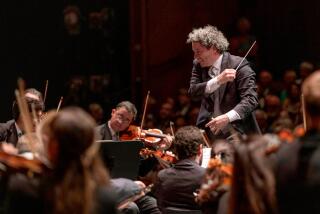Rachmaninoff still a Bowl star
- Share via
WHEN the Los Angeles Philharmonic first began giving concerts at the Hollywood Bowl in 1922, they were called “Symphonies Under the Stars,” and Rachmaninoff’s Second Symphony -- first performed in Russia 14 years earlier -- was relatively new music.
The music spoke to its time, and the work’s slow movement seemed to be exactly what the Bowl had in mind with that slogan. L.A. provided the warm evening and a brilliant nighttime sky. Rachmaninoff supplied the romance with a melody long and surging and insinuating, a melody deeply moody, as the Russian composer always was, but deeply sensual too.
Tuesday, Rachmaninoff’s Second, always welcomed by audiences, returned to the Bowl for the umpteenth time. But over the years, the symphony (or at least how it is played) has changed, the Bowl has changed, the Philharmonic has changed, we have changed. It was not a warm night, nor a starry one. The music was amplified aggressively and accurately, while on large video screens a camera seemed to wander through the orchestra more aimlessly than usual while still expecting to draw a listener’s gaze away from the star or two that peeked through the overcast sky.
Rachmaninoff’s heart still found its sleeve, but the Dutch conductor Edo de Waart put it there carefully, just so, with as little muss as possible.
And yet De Waart, who has married many times, clearly has a feeling for romance. The former music director of the San Francisco Symphony and Minnesota Orchestra, he is also a conductor with a reputation for temperament, for stormy relationships with players. He’s clearly tough; he currently heads the Hong Kong Philharmonic, which is known to be a particularly difficult, conductor-eating organization.
All those qualities came into play Tuesday, and they seemed to do so just right, in sumptuous-sounding and complexly textured Rachmaninoff that at its most savory was a bittersweet chocolate with an exceptionally high cocoa content and hardly any sugar. It left a heady and long-lasting aftertaste.
Rarely displaying much emotion in his gestures or expressions (and consequently, the camera avoided him, even though he was visually the most interesting thing on the stage), De Waart nonetheless got a mellow, full-bodied and deeply satisfying sound from the Philharmonic. He brought out exciting antiphonal interplay between the first and second violins, seated on opposite ends of the stage, and the sound system is now sophisticated enough that it reproduced these spatial effects effectively.
The concert opened with Wagner’s “Die Meistersinger” Overture, and here too De Waart elicited from the Philharmonic a tremendously involving orchestral texture, grainy enough to be sonically stimulating yet smoothly enveloping the senses.
In between, Jean-Yves Thibaudet was the soloist in Liszt’s Second Piano Concerto. Here is an artist who has been too easily typecast. A snappy dresser, he likes to present himself as a dashing pianist. He has a brilliant technique and favors a sparkling sound.
But under it all, he is quite a cool customer, too cool sometimes for the big Romantic concertos he often plays. In the Liszt, his fingerwork dazzled, and his rhythmic vivaciousness was more than a little crowd-friendly. Unlike De Waart, who often concluded phrases ambiguously, he treated everything as black and white, which is also how he dressed on this occasion -- white jacket, black shirt -- and he was not about to get any bloodstains on his gleaming sleeve.
I missed the questioning warmth that De Waart brought to Wagner and Rachmaninoff. But the camera loved the pianist, and so did the sound system, and fun was to be had. All that was missing was fireworks.
More to Read
The biggest entertainment stories
Get our big stories about Hollywood, film, television, music, arts, culture and more right in your inbox as soon as they publish.
You may occasionally receive promotional content from the Los Angeles Times.











